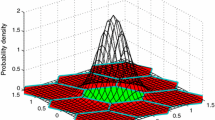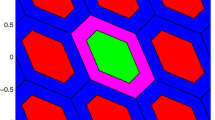Abstract
In the high-precision application of Global Navigation Satellite System (GNSS), integer ambiguity resolution is the key step to realize precise positioning and attitude determination. As the necessary part of quality control, integer aperture (IA) ambiguity resolution provides the theoretical and practical foundation for ambiguity validation. It is mainly realized by acceptance testing. Due to the constraint of correlation between ambiguities, it is impossible to realize the controlling of failure rate according to analytical formula. Hence, the fixed failure rate approach is implemented by Monte Carlo sampling. However, due to the characteristics of Monte Carlo sampling and look-up table, we have to face the problem of a large amount of time consumption if sufficient GNSS scenarios are included in the creation of look-up table. This restricts the fixed failure rate approach to be a post process approach if a look-up table is not available. Furthermore, if not enough GNSS scenarios are considered, the table may only be valid for a specific scenario or application. Besides this, the method of creating look-up table or look-up function still needs to be designed for each specific acceptance test. To overcome these problems in determination of critical values, this contribution will propose an instantaneous and CONtrollable (iCON) IA ambiguity resolution approach for the first time. The iCON approach has the following advantages: (a) critical value of acceptance test is independently determined based on the required failure rate and GNSS model without resorting to external information such as look-up table; (b) it can be realized instantaneously for most of IA estimators which have analytical probability formulas. The stronger GNSS model, the less time consumption; (c) it provides a new viewpoint to improve the research about IA estimation. To verify these conclusions, multi-frequency and multi-GNSS simulation experiments are implemented. Those results show that IA estimators based on iCON approach can realize controllable ambiguity resolution. Besides this, compared with ratio test IA based on look-up table, difference test IA and IA least square based on the iCON approach most of times have higher success rates and better controllability to failure rates.


















Similar content being viewed by others
References
Brack A (2015) On reliable data-driven partial GNSS ambiguity resolution. GPS Solut 19:1–12
Breiman L (1992) Probability. Addison-Wesley Pub Co, Massachusetts
Chandler D (1987) Introduction to modern statistical mechanics. Oxford University Press, New York
De Jonge P, Tiberius C (1996) The LAMBDA method for integer ambiguity estimation: implementation aspects. Publications of the Delft Computing Centre, Delft, LGR-series
Euler H-J, Schaffrin B (1991) On a measure for the discernibility between different ambiguity solutions in the static-kinematic GPS-mode. Springer, Berlin, pp 285–295
Feng Y, Wang J (2011) Computed success rates of various carrier phase integer estimation solutions and their comparison with statistical success rates. J Geod 85(2):93–103
Frei E, Beutler G (1990) Rapid static positioning based on the fast ambiguity resolution approach FARA: theory and first results. Manuscr Geod 15:325–356
Han S (1997) Quality-control issues relating to instantaneous ambiguity resolution for real-time GPS kinematic positioning. J Geod 71(6):351–361
Leick A (2004) GPS satellite surveying. John Wiley, New York
Li T, Wang J (2013) Theoretical upper bound and lower bound for integer aperture estimation fail-rate and practical implications. J Navig 66(3):321–333
Li T, Wang J (2014) Analysis of the upper bounds for the integer ambiguity validation statistics. GPS Solut 18:85–94
Li T, Zhang J, Wu M, Zhu J (2015) Integer aperture estimation comparison between ratio test and difference test: from theory to application. GPS Solut. doi:10.1007/s10291-015-0465-1
Misra P, Enge P (2006) Global positioning system: signals, measurements, and performance. Ganga-Jamuna Press, Lincoln
Moore M, Rizos C, Wang J (2002) Quality control issues relating to an attitude determination system using a multi-antenna gps array. Geom Res Australas 77:27–48
Nocedal J, Wright S (1999) Numerical optimization. Springer, New York
Odolinski R, Teunissen P, Odijk D (2014) First combined COMPASS/BeiDou-2 and GPS positioning results in Australia. Part ii: single and multiple-frequency single-baseline rtk positioning. J Spat Sci 59(1):25–46
Rubinstein RY, Kroese DP (2011) Simulation and the Monte Carlo method, vol 707. Wiley, New York
Teuniseen P (2001) The probability distribution of the ambiguity bootstrapped GNSS baseline. J Geod 75:267–275
Teunissen PJG, Odijk D, Zhang B (2010) PPP-RTK: results of CORS network-based ppp with integer ambiguity resolution. J Aeronaut Astronaut Aviat Ser A 42(4):223–230
Teunissen P (1993) Least-squares estimation of the integer GPS ambiguities. In: Invited lecture, section IV theory and methodology, IAG general meeting, Beijing, China
Teunissen P (1995) The least-squares ambiguity decorrelation adjustment: a method for fast GPS integer ambiguity estimation. J Geod 70(1–2):65–82
Teunissen P (1998a) On the integer normal distribution of the GPS ambiguities. Artif Satell 33(2):49–64
Teunissen P (1998b) Success probability of integer GPS ambiguity rounding and bootstrapping. J Geod 72(10):606–612
Teunissen P (1999) An optimality property of the integer least-squares estimator. J Geod 73(11):587–593
Teunissen P (2003) A carrier phase ambiguity estimator with easy-to-evaluate fail-rate. Artif Satell 38(3):89–96
Teunissen P (2004a) Integer aperture GNSS ambiguity resolution. Artif Satell 38(3):79–88
Teunissen P (2004b) Penalized GNSS ambiguity resolution. J Geod 78:235–244
Teunissen P (2005a) GNSS ambiguity resolution with optimally controlled failure rate. Artif Satell 40:219–227
Teunissen P (2005b) Integer aperture least-square estimation. Artif Satell 40(3):149–160
Teunissen P (2010) Integer least-square theory for the GNSS compass. J Geod 84:433–447
Teunissen P (2013) GNSS integer ambiguity validation: overview of theory and methods. In: Proceedings of The Institute of Navigation Pacific PNT, vol 2013, pp 673–684
Teunissen P, De Bakker P (2013) Single-receiver single-channel multi-frequency GNSS integrity: outliers, slips, and ionospheric disturbances. J Geod 87(2):161–177
Tiberius CCJM, de Jonge P (1995) Fast positioning using the LAMBDA method. In: Proceedings of 4th international conference differential satellite systems, paper 30, Bergen, Norway
Verhagen S (2005) The GNSS integer ambiguities : estimation and validation. PhD thesis
Verhagen S, Teunissen P (2006) New global navigation satellite system ambiguity resolution method compared to existing approaches. J Guid Cont Dyn 29(4):981–991
Verhagen S, Teunissen P (2013) The ratio test for future GNSS ambiguity resolution. GPS Solut 17(4):535–548
Verhagen S, Li B, Teunissen P (2013) Ps-LAMBDA ambiguity success rate evaluation software for interferometric applications. Comput Geosci 54:361–376
Wang J, Stewart M, Tsakiri M (1998) A discrimination test procedure for ambiguity resolution on-the-fly. J Geod 72(11):644–653
Wang L, Verhagen S (2015) A new ambiguity acceptance test threshold determination method with controllable failure rate. J Geod 89:361–375
Wang J, Feng Y, Wang C (2010) A modified inverse integer Cholesky decorrelation method and performance on resolution. J Glob Position Syst 9(2):156–165
Xu P (2001) Random simulation and GPS decorrelation. J Geod 75:408–423
Zhang J, Wu M, Li T, Zhang K (2015) Integer aperture ambiguity resolution based on difference test. J Geod. doi:10.1007/s00190-015-0806-4
Acknowledgments
Part of this research is funded by the scholarship provided by the China Scholarship Council (CSC). The first author would like to thank the invitation of Prof. Peter Teunissen in Delft University of Technology, the Netherlands. Dr. Sandra Verhagen in Delft University of Technology provided some original routines. Her support is also acknowledged.
Author information
Authors and Affiliations
Corresponding author
Appendix
Appendix
1.1 Proof of (29), (18) and (20)
In Teuniseen (2001), the general formula to calculate the PMF of IB estimator is given. Here, we give the specific and simple results in decorrelated space.
The original integer bootstrapped PMF is given below
with \({\check{a}}_1 \in \mathbb {Z}^n\) the best integer candidate and \(\check{a} \in N(a,Q_{ \hat{a} \hat{a}})\) the fixed solution.
As we know, \(Q_{\hat{a} \hat{a}} = LDL^\mathrm{T}\). After decorrelation,
with Z the decorrelated transformation matrix. We can say that \( Q_{\hat{z} \hat{z}} = I^\mathrm{T} D I \) with I the identity matrix.
In decorrelated space, (45) can be written as
with \(z_i = \check{z} - \check{z}_1\). As we know that
Apply (47) into (45). For the k-th integer candidate \(z(k) = \check{z}_k - \check{z}_1\) and \(z(k) = [z_1(k),\dots ,z_n(k) ]^\mathrm{T} \), we have
Obviously, for the best integer candidate, we have the same lower bound as (27). In decorrelated space, \(P_{\text {ILS}}(\check{z} = \check{z}_k)\) can be approximated by (46). Hence, (29) is proved when \(z(k) \ne 0\).
Similarly, before we derive formula (18), the PMF of DTIAB is firstly derived. Based on similar derivation steps in Teuniseen (2001), the formula below can be built in decorrelated space
with \(|x_i|\) the intersecting points between DTIAB pull-in region and coordinate axes. When \( \check{z} = \check{z}_1\), \(z(k)=0\). Then
For \(z(k) \ne 0\), we will have the PMF of DTIAB for each candidate
In decorrelated space, DTIAB almost has the same pull-in region as DTIA (Zhang et al. 2015). Hence,
Then, based on (51)
Formula (18) is proved.
Similarly, the PMF of IALS can be derived
Equation (20) is proved. \(\square \)
1.2 Proof for the properties of probability ratio factor
Property 1 is proved based on the following procedures. As to the PDF of normal distribution, \(x \in N(0,\sigma ^2)\),
Since f(x) is an even function and symmetry around y-axis, we will mainly talk about the property in \((0,+\infty )\) and then the other half can be derived similarly. Its first-order derivative
The second-derivative is
When \( x\in U \subset (\sigma ,\infty )\), f(x) is a monotonously decreasing and convex function. Based on the Jensity inequality (Chandler 1987), we have
with \(x_0 = z_i(k)-a_i\). Similarly, we also have \( f(\xi _x(k)) \ge f(x_0) \). It is obvious that \(\xi (k) \le x_0 \) and \(\xi _x(k) \le x_0\).
If \(\xi _x (k)< \xi (k)\), then \(f(\xi _x(k))>f(\xi (k))\). When \( |x_i| \rightarrow 0\)
This contradicts the conclusion with the inequality (54). Then we know that
Since f(x) is an even function, when \(U \subset (-\infty , -\sigma )\), f(x) is a monotonously increasing and convex function. Based on the proof by contradiction, we can derive that \( \xi _x (k) \le \xi (k) \) and
Hence, we can summarize that when
we have \(f(\xi _x (k)) \le f(\xi (k))\). Furthermore \( \xi _x (k) \le \xi (k) \) in \((-\infty ,-\sigma )\), and \( \xi _x (k) \ge \xi (k) \) in \((\sigma ,\infty )\).
The proof of property 2 is briefly given below. If \(\xi _x = x_0 + \delta _x\), \(\xi = x_0 + \delta \) and \(x_0 = z_i(k) -a_i\), when \( U \subset (\sigma ,\infty )\), we have \(\delta _x \ge \delta \) based on property 1. Then
When \(z_i(k) \rightarrow \infty \), \( 2(\delta -\delta _x)(z_i(k) -a_i) \rightarrow -\infty \) and , hence
Since \(0<|x_i| \le 1\), \(2|x_i|\le 1\), then
If \(z_i(k) \rightarrow \infty \), the integer candidate based on \(z_i(k)\) will rank as \(k \rightarrow \infty \)-th candidate. Eventually, the limiting case of probability ratio factor in Eq. (31) is
Similarly, when \(U \subset (-\infty ,\sigma ) \), we still can derive that
\(\square \)
Rights and permissions
About this article
Cite this article
Zhang, J., Wu, M., Li, T. et al. Instantaneous and controllable integer ambiguity resolution: review and an alternative approach. J Geod 89, 1089–1108 (2015). https://doi.org/10.1007/s00190-015-0836-y
Received:
Accepted:
Published:
Issue Date:
DOI: https://doi.org/10.1007/s00190-015-0836-y




